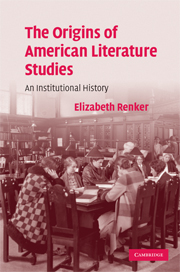Book contents
- Frontmatter
- Contents
- Acknowledgments
- Introduction
- Chapter 1 The birth of the Ph.D.: The Johns Hopkins research model
- Chapter 2 Seminary wars: female teachers and the seminary model at Mount Holyoke
- Chapter 3 Higher education for African Americans: competing models at Wilberforce University
- Chapter 4 Literary value and the land-grant model: The Ohio State University
- Conclusion: the end of the curriculum
- Notes
- Bibliography
- Archives consulted
- Index
Chapter 4 - Literary value and the land-grant model: The Ohio State University
Published online by Cambridge University Press: 22 September 2009
- Frontmatter
- Contents
- Acknowledgments
- Introduction
- Chapter 1 The birth of the Ph.D.: The Johns Hopkins research model
- Chapter 2 Seminary wars: female teachers and the seminary model at Mount Holyoke
- Chapter 3 Higher education for African Americans: competing models at Wilberforce University
- Chapter 4 Literary value and the land-grant model: The Ohio State University
- Conclusion: the end of the curriculum
- Notes
- Bibliography
- Archives consulted
- Index
Summary
The Ohio Agricultural and Mechanical College, later renamed The Ohio State University, opened in 1873 to educate “the industrial classes,” as the Morrill Act of 1862 had authorized. Inaugurating the land-grant college movement, The Morrill Act revolutionized higher education by transforming both the nature of its curriculum and the demographics of its student population. While the traditional classical curriculum held that the mental exercise involved in learning Greek and Latin trained the mind in an inherently valuable way, land-grant educators criticized the classics as useless, advocating the idea that the college curriculum should serve practical utility. And while the traditional classical colleges served a socially elite population, Morrill charged the land-grant schools to provide higher education to a sector of the population that had never before had such access. Put into practice, these two innovations carved out a new school model that competed with dramatic success in the chaotic late-nineteenth-century world of higher education.
The new idea of practical higher education for the mass of American youth aggressively changed the social function of the curriculum. College education was no longer presumed to serve elite male students seeking admission to the learned professions. Now both male and female students from all social spheres, including even the sons of dirt farmers presumably headed back to the family farm, had access to a form of higher education that claimed to serve their specific vocational needs.
- Type
- Chapter
- Information
- The Origins of American Literature StudiesAn Institutional History, pp. 95 - 125Publisher: Cambridge University PressPrint publication year: 2007



